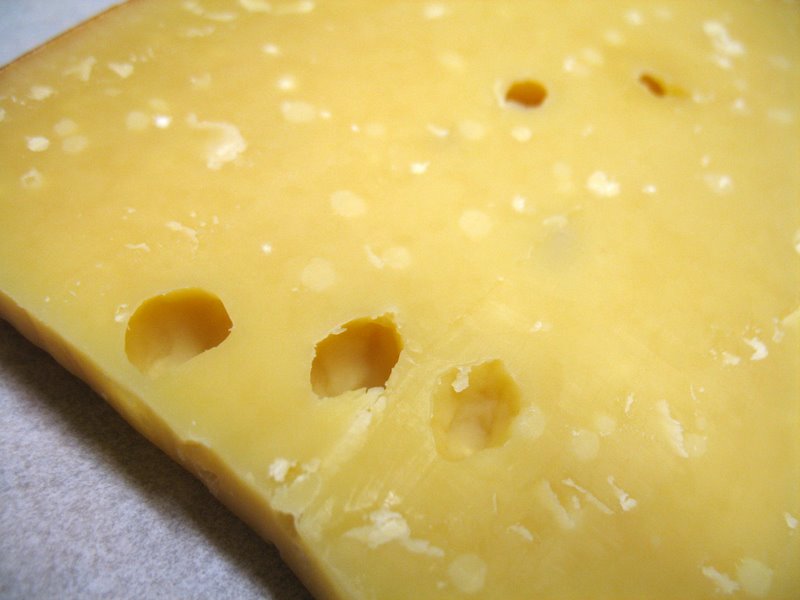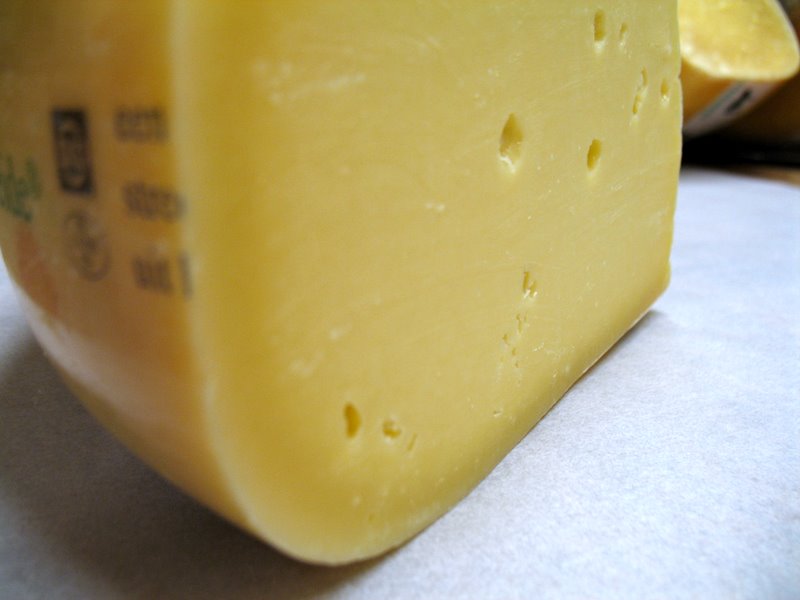
My first introduction to Gouda was the industrial variety that the Dutch ship all over the world: beige-ish, wrapped in red paraffin and fairly pliant. Traveling in Greece when I was sixteen, we bought Gouda, salami and fresh bread almost every day, making a quick sandwich for lunch. I thought those sandwiches were delicious – I think part of it was the fact that I was generally ravenous when lunch time came around – but, part of it was also the mild creaminess of the cheese paired with the salami.
The Dutch produce large volumes of cheese and about 75% of it is shipped overseas. Although they aren't quite the largest cheese-producing nation, because they export such a large percentage of their production, the Dutch are the world's largest exporters of cheese. And, 60% of the cheese the Dutch produce is Gouda. Gouda and Edam are produced in essentially the same way but the fat content of their milks differ - Gouda is made with whole milk and Edam with partially skimmed milk. For both of these cheeses, a necessary part of the cheesemaking process is 'washing' the curds.

After the curds and whey have separated, the curds are cut. Once that happens, a portion of the whey is removed and replaced with hot water. The temperature of the water is important because the heat scalds the curds, forcing out moisture. In the World Cheese Book, Juliet Harbutt tells us that the effect of this step is to removes lactose from the curd, bringing out the sweetness of the milk and making the curd more elastic. With less lactose, the lactic bacteria does not have as much to feed on, reducing the level of acidity in the cheese. (Interestingly, another example of a 'washed curd' cheese is cottage cheese - however, cold water is used instead).
My first experience was with the industrial variety but, working as a cheesemonger, I have been introduced to a whole different world of Gouda, the kind of Gouda that the Dutch generally keep for themselves: Boerenkaas. Literally, Boerenkaas translates to “farmer’s cheese.” Made with raw milk on small farms, Boerenkaas are rare in the United States. You can identify them by their golden rind (in contrast to the red paraffin), generally covered with some stickers or labels, indicating who made the cheese.

At the shop, we carry Boerenkaas from three different farms. The first is that of Magdalena and Nico Captein. The Capteins have a herd of about 70 red Friesian cows. The herd roams the pastures of their farm, Kaasboerderij Captein. And, their Gouda, named after Magdalena, is aged in the Capteins’ aging rooms for 18 months. In the above photo, you can see the crunchy bits (or denatured protein clusters) that come with age.

Another couple – Jan and Roos van Schie – make a Boerenkaas named Wilde Weide. Wilde Weide translates as “wild meadow,” a nod to the pastureland where their Montbéliarde and red Friesian cows graze. Located on a small island, Zwanburgerpolder, right smack in the center of the Netherlands, we generally import Wilde Weide anywhere from 6-10 months old.

Our third Boerenkaas, Veenweidekaas, comes from Lidia and Theo van Leeuwen. Based in the western part of the Netherlands, their farm is four centuries old and is built on a dike. Behind the dike is the “polder” (or dry, pumped land) where their 35 cows graze. The van Leeuwens are known for their commitment to sustainable production – for example, in the spring, Lidia and Theo locate all of the bird nests in their fields and take measures to protect them from being trampled by their herd. They are also careful to mow their meadows in a criss-cross pattern, leaving every other patch untouched for the birds, other wildlife and the wild flowers. As such, it seems appropriate that the Veenweidekaas label depicts a snipe and a lily.

Instead of storing their milk, the van Leeuwens make cheese every day, moving the milk as quickly as possible from cow, to curd form, to mold. This helps the cheese reflect as much of the freshness and flavors in the milk as possible. The van Leeuwens also choose to minimally salt their cheese, meaning that it ripens more slowly, developing more complexity. We generally carry two ages of Veenweidekaas – the younger version has a creamier texture while the Reserve is firmer, containing those crunchy denatured protein clusters.
With three different, amazing Gouda producers, you may ask yourself - how do you choose which one to take home? Indeed, given this kind of line-up, it is often a difficult proposition. My recommendation - taste them all as often as possible and pick the one you like best at that moment. Come on in to the shop and we would be happy to taste them with you!

